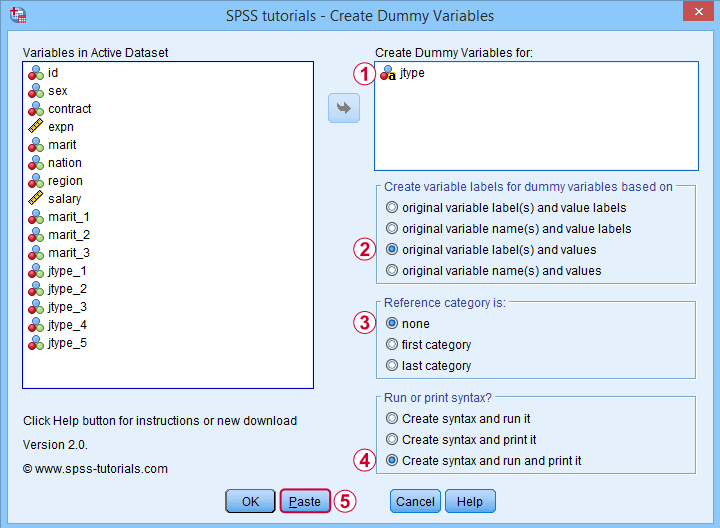
Otherwise, SPSS will consider the "blank" category as a valid category. In this situation, you must use Automatic Recode in order for SPSS to recognize blank strings as missing values. This is because SPSS, by default, recognizes "blank" strings as valid values. It also automatically adds value labels: whatever the string value was before becomes the value label.Īdditionally, if you have used blanks to indicate missing values for string variables, you may have noticed that SPSS doesn't automatically recognize those observations as missing. If you have already recorded your categorical variables as strings, you can easily convert them to a labeled, numerically coded variable using the Automatic Recode procedure. This procedure assigns each unique category a numeric code, then saves the converted values as a new variable. Mismatch (notice the extra space after string 1) (Note that if your data was originally recorded in Excel, it is very easy for the values of string variables to accidentally be recorded with extra spaces at the end.) String 1 This includes placing an extra space at the end of a string: the human eye won't detect the discrepancy, but the computer will. This is because, when referring to the content of a string during a computation, the content must match exactly. If the content of the two strings is not an exact match, the computer will not recognize them as identical. Either method of recording categorical variables is valid, but it is often easier to work with numeric codes in SPSS than it is to work with strings. VARIABLE LABELS DG1 'DG_Document group name'.When writing down the observed values of a categorical variable, you can choose to write the data values as words or as numeric codes.

If the document a quotation is part of also belongs to a document group, the value for the document group is 1.ĬOMPUTE DG1 = 0. Treatment of Document Groupsįor each case (= quotation) there is a document and document group variable. See Export for further Statistical Analysis.
#NORMALIZE VARIABLE SPSS CODE CODE#
Scaled codes are ignored in the computation of code groups variables. VARIABLE LABELS CG1 'name of code group'. Document Type Declaration.Ĭode groups in SPSS jobs count how many of the codes in the code group have been assigned to the quotation.Ĭode groups are named: CG1, CG2 and so on.ĬOMPUTE CG1 = C10 + C11 + C12 + C13 + C14 + C15. VALUE LABELS C3 0 'NO' 1 'bad' 2 'good' 3 'not so good'. VARIABLE LABELS C5 'Code name with more than 40 characters'.

You can convert it into human readable time by using a converter, for instance: Variable Labels The date of creation is shown in the unix timestamp format. SX and SY indicate the position of the upper left hand corner of the imageĮX and EY indicate the position of the lower right hand corner of the image Depending on the media type, they are used for different start and end coordinates. There are two variables for the start position (SY and SX) and two variables for the end position (EY and EX) for a quotation. VALUE LABELS for variables created from codes are:Įvery case (quotation) is described by the codes that are attached it to, the document,the position in the document (start and end position), author, media type and date of creation. VARIABLE LABELS are taken from code and code group names.
#NORMALIZE VARIABLE SPSS CODE GENERATOR#
The output of the SPSS generator is a complete SPSS syntax file containing variable definitions, optionally the data matrix and some default jobs statements: You can now run the file in SPSS, or make some changes to the syntax file before you run it. Specify all desired properties and click Create. Enable this option if you want SPSS to save the data as *.sav file after running the syntax file. Enable this option if you want templates for procedures included at the end of the syntax file.Ĭreate SAVE OUTFILE instruction. See Naming Convention For Scaled Codes.Ĭreate task section. The value separator is % by default, but can be changed to something else. This is for example useful if you want to use SPSS to calculate inter-coder reliability. Check if you want to export an additional variable that indicates the author for each quotation.


You only need to enter a name here if you generate separate data files.Ĭreate a fresh data file during next run can be unchecked if the data has not changed since it was last created. This name is used as the file name and as the FILE reference from the DATA LIST section. For regular size projects, leave this option unchecked. SPSS cannot handle large data sets within a syntax file. This is mandatory if the size of the matrix exceeds a certain size. Use separate file: When checked, the data matrix is written to a separate file. From the Import & Export tab select SPSS Job.


 0 kommentar(er)
0 kommentar(er)
